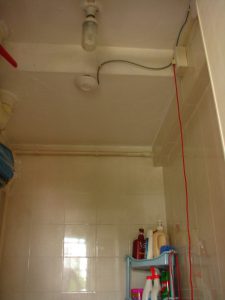Detection system that saves lives
A motion monitoring system developed by Ngee Ann Polytechnic allows seniors living alone to enjoy their independence and have peace of mind if something happens to them.
BY: Eleanor Yap
 There have been many reports of elderly who died alone in their flats, unbeknownst to their neighbours until their bodies decomposed and emitted a stench. To prevent such occurrences, a group of final-year electrical engineering students from Ngee Ann Polytechnic’s (NP) School of Engineering has developed a system to monitor seniors living alone and to send out a signal if no motion is detected after a certain time.
There have been many reports of elderly who died alone in their flats, unbeknownst to their neighbours until their bodies decomposed and emitted a stench. To prevent such occurrences, a group of final-year electrical engineering students from Ngee Ann Polytechnic’s (NP) School of Engineering has developed a system to monitor seniors living alone and to send out a signal if no motion is detected after a certain time.
Voluntary welfare organisation Lions Befrienders Service Association (Singapore) together with students and staff from NP had installed the motion monitoring system in the homes of two seniors – one in Mei Ling Street and the other in Jalan Bukit Merah. Costing $900 to install, the sensors detect movement and were mounted in different parts of the home such as the bedroom, kitchen, living room and toilet (left). There was also a sensor fixed on the door to indicate whether the senior had left or returned to the flat.
 Extra pair of eyes
Extra pair of eyes
So how does the sensor work? Data captured by the sensors is transmitted wirelessly via radio-frequency devices to a microcontroller, which automatically generates an SMS alert to the mobile phones of the caregivers when no motion is detected at a pre-set duration. The sensors serve as an extra pair of eyes since the caregivers – volunteers, family members or friends – cannot be with the seniors all the time.
During the four-month trial, which started August last year, the NP students were alarmed when no motion was observed for some time in the Jalan Bukit Merah home of an elderly man. They duly alerted the caregiver who checked and discovered that he was warded. The system was then fine-tuned to include another sensor at the door. Added Alwyn Chia, manager of communications and partnerships, “The outcome was successful. All fine-tuning efforts that were made had provided the intended solution in resolving the limitations of the system.”
Additional safety net
Currently, according to Lions Befrienders, some seniors under its care do have an emergency pull cord installed in their flats. When activated, the resident’s unit number will be flashed on the display board near the lift lobby on the ground floor and on the computer terminal installed in the office of the affected Lions Befrienders Neighbourhood Link. This is accompanied by a loud siren and an LED light outside the unit. The siren will go on and on until it is physically deactivated.
During office hours, staff of Lions Befrienders mans the system, while beyond office hours, volunteers are appointed to man it. However, the organisation explained that there may be situations such as with a massive heart attack or worse that could incapacitate the senior from pulling the cord. Unless someone happens to check on them, help may arrive too late.
Said Goh Boo Han, executive director of Lions Befrienders, of the system, “Installing such a device in the homes of the seniors under our care would complement the existing pull cord device. It would especially be useful to frail seniors given that they are susceptible to physical mishaps in their own homes.”
NP’s Electrical Engineering Division and Lions Befrienders are trying to get funding so it can install the system in 1,000 frail seniors’ homes or those living on their own (the other seniors in their care are not considered frail). The seniors it cares for are aged 65 and above and have limited or no family support. As of presstime, no funding has been announced. Chia noted that the sensor could also be useful in a working adult’s home. “Besides the seniors who live alone that could benefit from the motion monitoring system, other people can benefit as well. For example, this system could be useful to working adults who have dependents such as their own parents or grandparents who they have to care for at home during the day.”

0 Comments